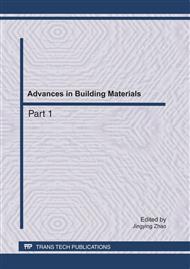p.398
p.402
p.407
p.411
p.416
p.421
p.426
p.431
p.436
Effects of Elevated Temperatures on the Compressive Strength of HFCC
Abstract:
This paper presents the results of elevated temperatures on the compressive of high fly ash content concrete (HFCC). The specimens were prepared with three different replacements of cement by fly ash 30%, 40% and 50% by mass and the residual compressive strength was tested after exposure to elevated temperature 250, 450, 550 and 650°C and room temperature respectively. The results showed that the compressive strength apparently decreased with the elevated temperature increased. The presence of fly ash was effective for improvement of the relative strength, which was the ratio of residual compressive strength after exposure to elevated temperature and ordinary concrete. The relative compressive strength of fly ash concrete was higher than those of ordinary concrete. Based on the experiments results, the alternating simulation formula to determine the relationship among relative strength, elevated temperature and fly ash replacement is developed by using regression of results, which provides the theoretical basis for the evaluation and repair of HFCC after elevated temperature.
Info:
Periodical:
Pages:
416-420
Citation:
Online since:
May 2011
Authors:
Price:
Сopyright:
© 2011 Trans Tech Publications Ltd. All Rights Reserved
Share:
Citation:


